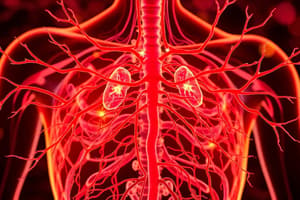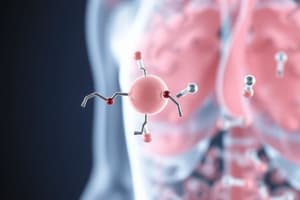Podcast
Questions and Answers
What type of hormonal effect occurs when hormones act on the same cell that produced them?
What type of hormonal effect occurs when hormones act on the same cell that produced them?
- Autocrine effect (correct)
- Exocrine effect
- Endocrine effect
- Paracrine effect
Which category of hormones includes compounds like norepinephrine and epinephrine?
Which category of hormones includes compounds like norepinephrine and epinephrine?
- Amines and amino acids (correct)
- Glycoproteins
- Peptides and proteins
- Steroids
What is the primary mechanism of release for protein hormones?
What is the primary mechanism of release for protein hormones?
- Vesicle-mediated synthesis and release (correct)
- Direct diffusion through the membrane
- Non-vesicle-mediated transport
- Simple excretion
Which of the following is NOT derived from cholesterol?
Which of the following is NOT derived from cholesterol?
What distinguishes a prohormone from a regular hormone?
What distinguishes a prohormone from a regular hormone?
What process is used for the synthesis of steroid hormones?
What process is used for the synthesis of steroid hormones?
Which hormones are classified as glycoproteins?
Which hormones are classified as glycoproteins?
What is the primary location where hormones are synthesized?
What is the primary location where hormones are synthesized?
Which hormone serves as a precursor for other hormones such as aldosterone and cortisol?
Which hormone serves as a precursor for other hormones such as aldosterone and cortisol?
How do steroid hormones typically circulate in the bloodstream?
How do steroid hormones typically circulate in the bloodstream?
What is the half-life of aldosterone when it is only 15% protein-bound?
What is the half-life of aldosterone when it is only 15% protein-bound?
What happens when drugs like aspirin compete with hormones for binding to carrier proteins?
What happens when drugs like aspirin compete with hormones for binding to carrier proteins?
What mechanism is primarily responsible for the degradation of peptide hormones in circulation?
What mechanism is primarily responsible for the degradation of peptide hormones in circulation?
Why must hormones be continuously inactivated?
Why must hormones be continuously inactivated?
Which of the following is true regarding the transport of steroid hormones?
Which of the following is true regarding the transport of steroid hormones?
What role do carrier proteins synthesized in the liver play in hormone regulation?
What role do carrier proteins synthesized in the liver play in hormone regulation?
What are the main management strategies for an acute adrenal crisis?
What are the main management strategies for an acute adrenal crisis?
What condition can cause acute adrenal insufficiency due to adrenal hemorrhage?
What condition can cause acute adrenal insufficiency due to adrenal hemorrhage?
Which of the following features is NOT a sign of Cushing syndrome?
Which of the following features is NOT a sign of Cushing syndrome?
How is Cushing syndrome diagnosed?
How is Cushing syndrome diagnosed?
What is a potential treatment for pituitary adenomas in Cushing syndrome?
What is a potential treatment for pituitary adenomas in Cushing syndrome?
Which therapeutic drug is commonly used for inoperable tumors in Cushing syndrome?
Which therapeutic drug is commonly used for inoperable tumors in Cushing syndrome?
Which of the following conditions is associated with excessive cortisol production?
Which of the following conditions is associated with excessive cortisol production?
What is the role of ACTH levels in Cushing syndrome diagnosis?
What is the role of ACTH levels in Cushing syndrome diagnosis?
Which symptom is commonly associated with glucocorticoid excess in Cushing syndrome?
Which symptom is commonly associated with glucocorticoid excess in Cushing syndrome?
What is the expected clinical feature caused by mineralocorticoid effects in Cushing syndrome?
What is the expected clinical feature caused by mineralocorticoid effects in Cushing syndrome?
Which of the following criteria can be used to diagnose Diabetes Mellitus?
Which of the following criteria can be used to diagnose Diabetes Mellitus?
What differentiates Type 1A Diabetes Mellitus from Type 1B Diabetes Mellitus?
What differentiates Type 1A Diabetes Mellitus from Type 1B Diabetes Mellitus?
What is a common result of insulin deficiency in Type 1A Diabetes Mellitus?
What is a common result of insulin deficiency in Type 1A Diabetes Mellitus?
Which of the following statements is true regarding the prevalence of Type 1 Diabetes Mellitus?
Which of the following statements is true regarding the prevalence of Type 1 Diabetes Mellitus?
What role do autoantibodies play in Type 1A Diabetes Mellitus?
What role do autoantibodies play in Type 1A Diabetes Mellitus?
What is the primary issue in Congenital Adrenal Hyperplasia (CAH)?
What is the primary issue in Congenital Adrenal Hyperplasia (CAH)?
Which enzyme deficiency is most commonly associated with a salt-losing form of CAH?
Which enzyme deficiency is most commonly associated with a salt-losing form of CAH?
What clinical manifestation may be observed in female infants with CAH?
What clinical manifestation may be observed in female infants with CAH?
Which of the following is a common treatment for CAH?
Which of the following is a common treatment for CAH?
Which type of CAH can lead to hypertension due to overproduction of 11-deoxycorticosterone?
Which type of CAH can lead to hypertension due to overproduction of 11-deoxycorticosterone?
What is a common diagnostic method for Congenital Adrenal Hyperplasia (CAH)?
What is a common diagnostic method for Congenital Adrenal Hyperplasia (CAH)?
What long-term effect may occur despite treatment in patients with CAH?
What long-term effect may occur despite treatment in patients with CAH?
In which scenario would surgical intervention be necessary for female infants with CAH?
In which scenario would surgical intervention be necessary for female infants with CAH?
What characteristic is associated with the simple virilizing form of CAH?
What characteristic is associated with the simple virilizing form of CAH?
What is the genetic inheritance pattern of Congenital Adrenal Hyperplasia (CAH)?
What is the genetic inheritance pattern of Congenital Adrenal Hyperplasia (CAH)?
Flashcards
What is the Autocrine Effect?
What is the Autocrine Effect?
Hormones act on the same cell that produced them.
What is the Intracrine Effect?
What is the Intracrine Effect?
Hormones are synthesized and act within the same cell.
What type of hormones are Amines and Amino Acids?
What type of hormones are Amines and Amino Acids?
Hormones derived from a single amino acid, like norepinephrine and epinephrine.
What type of hormones are Peptides and Proteins?
What type of hormones are Peptides and Proteins?
Signup and view all the flashcards
What are Glycoproteins?
What are Glycoproteins?
Signup and view all the flashcards
What type of hormones are Steroids?
What type of hormones are Steroids?
Signup and view all the flashcards
How are hormones synthesized and released?
How are hormones synthesized and released?
Signup and view all the flashcards
How are steroid hormones transported?
How are steroid hormones transported?
Signup and view all the flashcards
What effect does the carrier protein have on hormone activity?
What effect does the carrier protein have on hormone activity?
Signup and view all the flashcards
What is the half-life of a hormone?
What is the half-life of a hormone?
Signup and view all the flashcards
Why is hormone inactivation necessary?
Why is hormone inactivation necessary?
Signup and view all the flashcards
How are peptide hormones and catecholamines inactivated?
How are peptide hormones and catecholamines inactivated?
Signup and view all the flashcards
What are the mechanisms for degrading peptide hormones?
What are the mechanisms for degrading peptide hormones?
Signup and view all the flashcards
What is the state of steroid hormones when bound to carrier proteins?
What is the state of steroid hormones when bound to carrier proteins?
Signup and view all the flashcards
How can drugs affect hormone action by interfering with carrier proteins?
How can drugs affect hormone action by interfering with carrier proteins?
Signup and view all the flashcards
What is Acute Adrenal Insufficiency?
What is Acute Adrenal Insufficiency?
Signup and view all the flashcards
What are the symptoms of Acute Adrenal Insufficiency?
What are the symptoms of Acute Adrenal Insufficiency?
Signup and view all the flashcards
What is Congenital Adrenal Hyperplasia (CAH)?
What is Congenital Adrenal Hyperplasia (CAH)?
Signup and view all the flashcards
What is Cushing Syndrome?
What is Cushing Syndrome?
Signup and view all the flashcards
What is Cushing Disease?
What is Cushing Disease?
Signup and view all the flashcards
What is Adrenal Tumor Cushing Syndrome?
What is Adrenal Tumor Cushing Syndrome?
Signup and view all the flashcards
What is Ectopic Cushing Syndrome?
What is Ectopic Cushing Syndrome?
Signup and view all the flashcards
What is Iatrogenic Cushing Syndrome?
What is Iatrogenic Cushing Syndrome?
Signup and view all the flashcards
What are the clinical manifestations of Cushing Syndrome?
What are the clinical manifestations of Cushing Syndrome?
Signup and view all the flashcards
How is Cushing Syndrome diagnosed?
How is Cushing Syndrome diagnosed?
Signup and view all the flashcards
What is the primary issue in CAH?
What is the primary issue in CAH?
Signup and view all the flashcards
How does CAH affect female infants?
How does CAH affect female infants?
Signup and view all the flashcards
What is 21-hydroxylase deficiency?
What is 21-hydroxylase deficiency?
Signup and view all the flashcards
What is salt-losing CAH?
What is salt-losing CAH?
Signup and view all the flashcards
What is 11-β-hydroxylase deficiency?
What is 11-β-hydroxylase deficiency?
Signup and view all the flashcards
How is CAH diagnosed?
How is CAH diagnosed?
Signup and view all the flashcards
What is the treatment for CAH?
What is the treatment for CAH?
Signup and view all the flashcards
When is surgery needed for CAH?
When is surgery needed for CAH?
Signup and view all the flashcards
What is Adrenal Insufficiency?
What is Adrenal Insufficiency?
Signup and view all the flashcards
What is Type 1 Diabetes Mellitus (DM)?
What is Type 1 Diabetes Mellitus (DM)?
Signup and view all the flashcards
What is Type 1A Diabetes Mellitus?
What is Type 1A Diabetes Mellitus?
Signup and view all the flashcards
What is Type 1B Diabetes Mellitus?
What is Type 1B Diabetes Mellitus?
Signup and view all the flashcards
What is Type 2 Diabetes Mellitus?
What is Type 2 Diabetes Mellitus?
Signup and view all the flashcards
What is HbA1c?
What is HbA1c?
Signup and view all the flashcards
Study Notes
Endocrine System
- The endocrine system plays a critical role in integrating essential life functions, including growth, sex differentiation, metabolism, and adaptation to changing environmental conditions
- This system uses hormones to regulate and coordinate body functions
- It is closely associated with the nervous and immune systems
- The endocrine system utilizes chemical messengers called hormones to regulate and integrate various bodily processes
- Hormones are chemical messengers transported through body fluids
- Specialized organic molecules produced by endocrine organs to act on specific target cells
- Hormones do not start reactions but modulate cellular and systemic responses
- Hormones are released from several sites, including the endocrine glands, the brain, and other organs such as the heart, liver, and adipose tissue.
Hormones
- Definition: Chemical messengers transported through body fluids
- Specialized organic molecules: Produced by endocrine organs to act on specific target cells
- Do not start reactions: Modulate cellular and systemic responses
Hormone Effects and Actions
- Endocrine Effect: Hormones are released into the bloodstream and act on distant target cells
- Paracrine Effect: Hormones act locally on nearby cells without entering the bloodstream
- Autocrine Effect: Hormones act on the same cell that produced them
- Intracrine Effect: Hormones are synthesized and act within the same cell
Structural Classification of Hormones
- Amines and Amino Acids: Derived from single amino acids (e.g., norepinephrine, epinephrine, thyroid hormones)
- Peptides and Proteins: Range from small molecules to large proteins (e.g., thyrotropin-releasing hormone, growth hormone)
- Steroids: Derived from cholesterol (e.g., cortisol, estrogen, testosterone)
Synthesis, Release, Transport, and Elimination of Hormones
- Synthesis and Release: Varies based on hormone structure, with protein hormones synthesized and stored in vesicles and steroid hormones synthesized and secreted immediately.
- Mechanism: Protein hormones utilize vesicle-mediated release pathways. Precursor hormones are often modified, and if extra amino acids exist, they are considered a prohormone.
- Release Mechanism: Hormone cell stimulation triggers vesicle movement to the cell membrane, releasing hormones.
- Non-Vesicle-Mediated Hormones: Include some nonpolypeptide hormones and neurotransmitters, such as catecholamines.
- Transport: Hormones circulate as free or unbound molecules or bound to transport carriers.
- Half-life Examples: Thyroxine and Aldosterone have varying half-lives.
- Drugs: Certain drugs compete with hormones for binding to transport carriers.
Metabolism and Elimination of Hormones
- Hormones must be continuously inactivated to prevent accumulation.
- Mechanisms include intracellular and extracellular processes.
- Peptide hormones and catecholamines are degraded by enzymes in the blood or tissues.
- Steroid hormones are transported bound to protein carriers and remain inactive in the bound state.
Mechanisms of Hormone Action
- Hormones interact with high-affinity receptors linked to effector systems within the cell.
- These mechanisms influence metabolic activities such as ion transport at the cell surface and stimulation of nuclear transcription.
- Reaction time varies depending on the mechanism (e.g., milliseconds for neurotransmitters, days for thyroid hormones).
Hormone Receptors
- Cell-Surface Receptors: Used by peptide hormones and catecholamines; hormones bind to surface receptors
- Intracellular Receptors: Used by steroid and thyroid hormones, which cross the cell membrane and bind to intracellular receptors
Control of Hormone Levels
- Hormone secretion varies over a 24-hour period with diurnal fluctuations, cyclic secretion, and feedback regulation.
- Hypothalamic-Pituitary Regulation: The hypothalamus and pituitary form a control unit for various endocrine and physiological functions, connected by the hypophysial portal system.
Diagnostic Tests in Endocrinology
- Direct Measurement of Hormones: Measures hormone levels in blood or other samples
- Indirect Methods: Assess the physiological effects of hormones (e.g., blood glucose as a marker for insulin availability)
- Radioimmunoassay (RIA): Measures plasma hormone levels through competitive binding
- Immunoradiometric Assay (IRMA): A more specific version of RIA that uses two antibodies for better specificity.
- Autoantibody Testing: Detects autoimmune endocrine disorders
Stimulation and Suppression Tests
- Used to evaluate suspected hypofunction or hyperfunction of an endocrine organ
- Hormonal testing and imaging are important aspects of diagnosis and management in endocrinology.
Hypofunction and Hyperfunction of the Endocrine System
- Hypofunction: Decreased activity resulting in reduced hormone production (e.g., developmental issues, enzyme deficiencies, gland destruction, aging/atrophy, or receptor defects)
- Hyperfunction: Excessive hormone production due to overstimulation or abnormal gland activity (e.g., hyperplasia, hormone-producing tumors).
Hormone Secretion Patterns
- Hormone secretion varies over a 24-hour period (diurnal fluctuations).
- Cyclic secretion, such as in female sex hormones.
- Feedback regulation, such as insulin (glucose levels) and antidiuretic hormone (water levels)
Growth Hormones
- Growth hormone (GH) has several metabolic effects, including stimulating protein synthesis, mobilizing fatty acids, and antagonizing insulin actions.
- It plays a crucial role in growth, particularly during childhood, by promoting bone and cartilage formation.
Hormones Essential for Growth and Maturation
- Growth hormone (GH): Promotes bone and cartilage growth and regulates metabolic processes.
- Insulin: Supports growth by its role in carbohydrate and fat metabolism; deficiency can impair growth in children.
- Thyroid hormones: Essential for bone growth and epiphyseal closure; low levels delay growth processes.
- Androgens: Stimulate protein synthesis, contributing to growth.
- Glucocorticoids: Excessive levels inhibit growth.
Hypothalamic-Pituitary-Target Cell Feedback
- Complex hormone regulation within the thyroid, adrenal cortex, and gonads
- The hypothalamus secretes a releasing hormone, stimulating the anterior pituitary to secrete a tropic hormone.
- The tropic hormone then stimulates a peripheral target gland to produce its hormone
Positive and Negative Feedback
- Negative Feedback: Most common; hormone or its effect inhibits further secretion to maintain balance
- Positive Feedback: Less common; hormone stimulates continued secretion until a specific event occurs
Diabetes Mellitus
- Metabolic disorder characterized by hyperglycemia
- Imbalance between insulin availability, glucose utilization, and glucose production
- Type 1 Diabetes: Beta cell destruction, absolute insulin deficiency
- Type 2 Diabetes: Insulin resistance, relative insulin deficiency
- Other Types: Genetic defects, endocrinopathies, diseases of the pancreas, drug or chemical induction, or infections
Diagnostic Tests for Diabetes
- Fasting Blood Glucose Test (FPG): measures glucose levels after an 8-hour fast
- Casual Blood Glucose Test: measures blood glucose without regard for the time of the last meal
- Oral Glucose Tolerance Test (OGTT): measures the body's ability to store glucose after ingesting a glucose solution
- Capillary Blood Glucose Monitoring: Measures blood glucose from a finger-stick or forearm sample
- Continuous Glucose Monitoring (CGM): Provides frequent glucose readings using subcutaneous catheters
- Glycated Hemoglobin (A1C) test: Measures average blood glucose over the past 6-12 weeks.
Diabetes Treatment
- Goals: Normalize blood glucose to prevent short- and long-term complications
- Components: Medical Nutrition Therapy (MNT) tailored for individual needs, exercise, and pharmacological treatment
Acute and Chronic Complications of Diabetes
- Acute Complications: Diabetic ketoacidosis (DKA), hyperosmolar hyperglycemic state (HHS), and hypoglycemia
- Chronic Complications: Microvascular complications (neuropathies, nephropathies, retinopathies), macrovascular complications (coronary artery disease, cerebrovascular disease, and peripheral vascular disease), foot ulcers, and gastrointestinal motility disorders
Sex-Hormone Therapy
- Estrogen therapy for girls or testosterone therapy for boys can accelerate epiphyseal plate closure in precocious puberty
Other Pancreatic Disease and Endocrine Disorders
- Various diseases can cause diabetes by affecting pancreas function or increasing hepatic glucose production, or decreasing glucose utilization
- Diabetes is possible as a result of, or in combination with, other disorders
Adrenal Function
- The adrenal glands are involved in multiple metabolic functions, including response to stress and regulating electrolyte balance
- Cortisol: crucial for maintaining blood glucose levels, immune response and metabolic processes
- Aldosterone: regulates sodium and potassium balance, vital for blood pressure control
Adrenal Disorders
- Adrenal cortical insufficiency (Addison's disease): deficiency in adrenal cortical hormones and elevated ACTH levels, triggered primarily by autoimmune destruction of adrenocortical tissue.
- Congenital adrenal hyperplasia (CAH): Genetic disorder, resulting from abnormalities in adrenal steroid synthesis or excretion
Studying That Suits You
Use AI to generate personalized quizzes and flashcards to suit your learning preferences.




